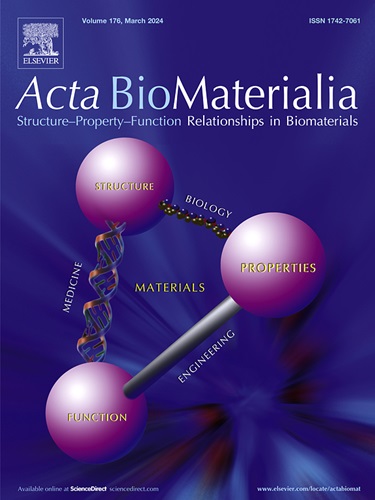Syngeneic adipose-derived stromal cells modulate the immune response but have limited persistence within decellularized adipose tissue implants in C57BL/6 mice
IF 9.4
1区 医学
Q1 ENGINEERING, BIOMEDICAL
引用次数: 0
Abstract
The delivery of adipose-derived stromal cells (ASCs) on cell-instructive decellularized adipose tissue (DAT) scaffolds is a promising strategy for stimulating host-derived soft tissue regeneration. However, a better understanding of the mechanisms through which ASCs modulate regeneration in vivo is needed to harness these cells more effectively. In this study, DAT scaffolds, both with and without seeded syngeneic DsRED+ mouse ASCs, were implanted into immunocompetent C57BL/6 mice. Downstream analyses focused on assessing donor ASC persistence and phenotype, as well as the effects of ASC seeding on host macrophage polarization and the perfused host vascular network. Notably, most donor ASCs were cleared from the scaffolds by 2 weeks. Mass spectrometry-based proteomics indicated that the transplanted ASCs maintained their pre-implantation phenotype up to 1 week in vivo, suggesting that the cells were not undergoing programmed cell death. A higher fraction of the infiltrating host macrophages expressed CD68 and Arginase-1 in the ASC-seeded implants up to 1-week post-implantation. Interestingly, a small population of phagocytic macrophages, identified by uptake of DsRED protein, was present in the DAT implants in the first 2 weeks and showed enhanced expression of CD68, Arginase-1, and CD163, along with reduced expression of iNOS. MicroCT angiography revealed a similar perfused vessel network in the seeded and unseeded groups at 4- and 8-weeks post-implantation. Overall, seeding with syngeneic ASCs modulated the host macrophage response to the DAT bioscaffolds at early timepoints, but did not impact long-term regenerative outcomes, potentially due to the rapid clearance of the donor cell population in this model.
Statement of Significance
Decellularized adipose tissue (DAT) is a promising biomaterial for treating soft tissue defects. Seeding with adipose-derived stromal cells (ASCs) can augment fat regeneration within DAT in pre-clinical models, but our understanding of how ASCs contribute to tissue regeneration in vivo remains limited. Furthermore, ASC clearance from implanted biomaterials is well described, but poorly understood. Here, ASC-seeded DAT was implanted subcutaneously in immunocompetent mice to assess how ASCs altered the host macrophage response, functional vascular regeneration, and long-term integration with the host tissues. Additionally, ASC phenotype and persistence were assessed to determine how these cells might be cleared from the implants. Such understanding is critical to design biomaterials that can better harness the therapeutic benefits of ASCs.

求助全文
约1分钟内获得全文
求助全文
来源期刊

Acta Biomaterialia
工程技术-材料科学:生物材料
CiteScore
16.80
自引率
3.10%
发文量
776
审稿时长
30 days
期刊介绍:
Acta Biomaterialia is a monthly peer-reviewed scientific journal published by Elsevier. The journal was established in January 2005. The editor-in-chief is W.R. Wagner (University of Pittsburgh). The journal covers research in biomaterials science, including the interrelationship of biomaterial structure and function from macroscale to nanoscale. Topical coverage includes biomedical and biocompatible materials.
 求助内容:
求助内容: 应助结果提醒方式:
应助结果提醒方式:


